
02/18/2010
Furci Home / Fitness Channel / Bullz-Eye Home
Shredded is a term used to describe somebody who has extremely low body fat levels. I'm not talking about somebody who is lean, has definition and you can see their abs. A person who is shredded, like some bodybuilders, has skin that is like cellophane. You'd swear they didn't have skin at all because you can see the striations in every muscle. Getting to the point of being shredded is extremely difficult. It's so difficult that most bodybuilders who put 110 percent effort into attaining this appearance for a contest fail.
Because of the amount of effort involved -- primarily because maintaining this look is such a harsh condition for the body -- being shredded is a transient state. Bodybuilders and models alike attain this condition for their respective competitions and photo shoots. Once the event is over, many return back to a lean state, while some get completely out of shape. The pictures of shredded individuals you see in advertisements claiming a product made them that way are simply lying.
Advertisements for losing body fat are everywhere, making outrageous claims, peddling miracle supplements and exercise machines. But are there products, supplements or machines that can really make you Shredded, Ripped, Cut Up, Lean? Unfortunately, for the legions of people who have wasted their money, there is no product that if used alone will make them shredded. However, there are products that can help you reach your goal, and we'll be discussing these later in this article.
 One of my favorite mottoes is, "If it sounds too good to be true, then it probably is." Another one of my favorites is, "There is no such thing as a free lunch." So when you see an ad that makes a claim like, "Ripped abs in 6 weeks by using the Thingamajig!" or "I just took one youbetcha pill a day and got shredded in 4 weeks!" -- don't give it a second look. There is so much more to getting shredded than taking a pill or using a thingamajig.
One of my favorite mottoes is, "If it sounds too good to be true, then it probably is." Another one of my favorites is, "There is no such thing as a free lunch." So when you see an ad that makes a claim like, "Ripped abs in 6 weeks by using the Thingamajig!" or "I just took one youbetcha pill a day and got shredded in 4 weeks!" -- don't give it a second look. There is so much more to getting shredded than taking a pill or using a thingamajig.
In order to change the way your body looks, you have to change your lifestyle. In order to change your lifestyle, you have to educate yourself. Haphazardly making changes and expecting results is like driving to a place you've never been without a map and expecting to get there. Even when you have a map, there are unexpected hurdles. The key is to be patient, remain motivated, and make adjustments when necessary.
Getting Ripped 101
THE CALORIE THEORY
Many so-called experts think there is only one thing that matters when trying to lose weight: calories consumed versus calories used. They try to lead you to believe that a calorie of protein is equal to a calorie of fat is equal to a calorie of carbs, and that all you have to do is cut down the amount consumed to lose body fat. In order for this to be true, the physiological processes by which the human body transforms food into energy – metabolism – would have to be the same for every type of food. This is a simplistic, unscientific and untenable view.
All macronutrients -- including fats, carbohydrates and proteins -- contain energy. The energy contained in food is expressed as calories. We tend to associate calories with food, but in reality, calories apply to anything. For example, a gallon of gasoline contains approximately 31 million calories.
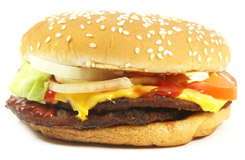 A calorie is the amount of heat needed to raise 1 kilogram of water 1 degree Celsius at sea level. What does this mean? A Double Whopper with cheese contains 960 calories. If we were to burn this burger, it would produce 960 calories -- enough energy to raise 960 kilograms of water 1 degree Celsius.
A calorie is the amount of heat needed to raise 1 kilogram of water 1 degree Celsius at sea level. What does this mean? A Double Whopper with cheese contains 960 calories. If we were to burn this burger, it would produce 960 calories -- enough energy to raise 960 kilograms of water 1 degree Celsius.
Calorie is a shortened name for kilocalories, to reflect the simplified math. A kilocalorie contains 1,000 calories, so the Double Whopper with cheese is actually 960,000 calories. Now don't get your panties in a bunch -- this simplified math also applies to exercise calorie charts. If the piece of cardio equipment you're using says you burned 200 calories, it's simplified for 200,000 calories. However, don't rely on exercise equipment charts -- they are grossly inaccurate. This is due to several factors, mainly genetics, because the rate at which individuals burn calories varies greatly and cannot be measured on a piece of cardio equipment.
Calories can and are measured in a sealed device called a "calorimeter" which locks in heat of burning food. A small vacuum container of water is contained above the food. Once the food is completely burned, the temperature of the water is measured. The rise in temperature will determine the amount of calories. While the calorimeter can show the total amount of energy in a serving of Fruit Loops, it cannot account for what the human body doesn't absorb, or the energy used in the digestion and assimilation of it. It also cannot show one's ability and efficiency to use food as energy, as opposed to storing it as fat.
Does counting the number of calories consumed matter, or is it even necessary when trying to lose weight? No! Counting calories is completely inaccurate and a waste of time. Our bodies do not process food like a calorimeter. The assertion that macronutrients are all processed the same between individuals is just foolish. Yet, this is the basis for the calorie theory.
Macro Nutrients
CARBOHYDRATES: THE SMOKING GUN
The enemy of weight loss and health is not fat, protein or carbohydrates. It's the types of these foods, along with other man-made substances consumed, in the low fat/high carbohydrate diet that has been forced upon us by the medical community, food and edible oil industries. Started in the mid 1950s as the Lipid Hypothesis , this politically correct diet has been a dismal failure. We are getting fatter and unhealthier because we are eating anything other than what our bodies are designed to process. Add to this the fact that most Americans get the vast majority of their physical activity walking to and from their cars, and you have a recipe for disaster.
 Although a lack of physical activity has a part to play in our being fat, carbohydrates, especially simple carbs or sugar, shoulder most of the blame. The sole purpose of carbohydrates is to provide energy. Whatever your body doesn't use as fuel, is stored as fat. Carbohydrates are a non-essential nutrient, meaning humans do not need to consume them for survival or even health. Our bodies function perfectly -- and are much healthier -- without carbohydrates, especially sugars and starches.
Although a lack of physical activity has a part to play in our being fat, carbohydrates, especially simple carbs or sugar, shoulder most of the blame. The sole purpose of carbohydrates is to provide energy. Whatever your body doesn't use as fuel, is stored as fat. Carbohydrates are a non-essential nutrient, meaning humans do not need to consume them for survival or even health. Our bodies function perfectly -- and are much healthier -- without carbohydrates, especially sugars and starches.
In order to understand why carbohydrates are your worst enemy when trying to get lean, you have to understand insulin. Insulin is the fat storage hormone. Quite simply, the higher your insulin levels, the more you store food as fat.
As you eat carbs, the body breaks them down into a simple, more absorbable sugar called glucose. The glucose is then transported to the blood stream. As your blood glucose levels rise, this sends a signal to the pancreas to release insulin. Insulin governs the processing of glucose. Without insulin, as with type I diabetics, glucose levels will rise, eventually causing ketoacidosis. If not treated, it will cause death.
Glucose is processed by insulin in two different ways. As glucose levels rise, insulin converts a portion of it to glycogen, which is stored in the muscle cells and the liver. Once all the storage space is taken up (and it doesn't take much especially if you don't exercise), insulin will convert the rest to triglycerides and store it as adipose tissue – fat. Insulin is a facilitator of lipogenesis, or fat storage, and is a deterrent to lipolysis, or the breaking down of fat for energy. Even low levels of circulating insulin have been shown to prevent the breakdown of fat to be used as energy. Hence, as stated above, insulin is the fat storage hormone.
Does fat make you fat?
We tend to refer to them as oils if they're liquid at room temperature, like olive oil. And we refer to them as fat if they are solid at room temperature, like beef tallow, coconut oil or butter. But whether liquid or solid, they're all fat.
Technically called lipids, fats and oils are made up of many different types of fatty acids. Fatty acids are the same whether they come from plants or animals. Oleic acid that is found in olive oil is exactly the same as the oleic acid found in lard (pig fat). What many don't know is that lard is actually a monounsaturated fat. It's the proportions of fatty acids that will vary from plant to plant, from animal to animal, and from plant to animal.
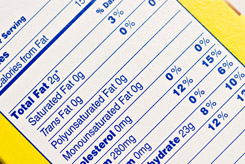 A fatty acid is a molecule that is made up of a chain of carbon atoms. These chains can vary in length from 1 to 24 carbons. Fatty acids are given their names based on how long the chain is, and at what position the "unsaturation" occurs. If the fatty acid is saturated, then the carbon chain length determines the name.
A fatty acid is a molecule that is made up of a chain of carbon atoms. These chains can vary in length from 1 to 24 carbons. Fatty acids are given their names based on how long the chain is, and at what position the "unsaturation" occurs. If the fatty acid is saturated, then the carbon chain length determines the name.
What is a saturated fat? Each carbon atom in the fatty acid chain has room for two hydrogen molecules, except at the end where it has room for three. A fatty acid with two hydrogen atoms for every carbon atom in the chain is said to be saturated.
A fatty acid missing two or more hydrogen atoms along the chain, which causes double bonds between carbon atoms, is said to be unsaturated. If there is one double bond, the fatty acid is referred to as monounsaturated. If there are two or more double bonds found along the chain, the fatty acid is referred to as polyunsaturated.
Fat has many functions in addition to being used as an energy source, and unlike carbohydrates, certain fats are essential. Without consuming essential fatty acids (like omega-3), attaining optimum health is virtually impossible. A diet deficient in omega-3s, like the typical western diet, is a major risk factor in the pathologies of several diseases like cancer, depression, autoimmune disorders and cardiovascular disease (1-4). Including the right fats in your diet will not only improve your health, but aid in fat loss.
But how does fat help us get lean? Fat satiates the appetite, and helps to stop the cravings for sugar. But probably most importantly, fat -- when combined with a low carbohydrate intake -- actually aids in burning fat as fuel. That's right -- fat helps burn fat! When fat is restricted, our bodies have a defense mechanism built in for survival. Our bodies will actually stop using fat as fuel in an effort to preserve our stores for future use.
Bodybuilders and fitness competitors have known this for years simply through trial and error, while dieting for competitions. Many bodybuilders while dieting for shows would reach a certain body fat percentage and suddenly plateau for no apparent reason. We found that by adding fat to the diet (like olive oil, flaxseed oil, or especially coconut oil) it would jump-start the body to burn body fat.
Sounds bizarre doesn't it? Especially since it goes against what we've been taught: in order to lose fat you have to cut fat from your diet. But the reality is, fat burns fat. However, just adding fat to the diet doesn't ensure you'll get lean; you need to consume the right types of fat and eat a diet low in carbs. For a more in-depth explanation on the different types of fats, and which ones to include in your diet and which ones exclude, read "Fats, cholesterol and the lipid hypothesis".
Protein is #1
Protein is by far the single most important nutrient/supplement you can consume in your quest to get lean, and add muscle and strength. Protein repairs and maintains everything in our bodies from hormones to muscles to bones. Proteins are made up of building blocks called amino acids. There are nine essential amino acids. Essential meaning we have to ingest these for survival because our bodies cannot manufacture them. Many researchers now believe we have many other amino acids that should be considered "conditionally essential," because of their significance and our inefficiency at producing them. These include glutamine, arginine, cysteine, taurine, glycine, tyrosine and proline.
Consciously consuming a diet low in protein has no benefit; it is not based on good science, and merely a matter of ignorance. If your protein intake or quality is low, your body will get the essential aminos it needs from its most abundant storage system -- muscle tissue. The International Society of Sports Nutrition, in a 2007 position statement, concluded that bodybuilders and strength/power athletes require just under a gram of protein per pound of body weight per day (5), consistent with my recommendation of 1 gram per pound of lean body weight. However, if you train intensely, which is how you should train, empirical data suggests you may need upwards of 1.5 g/lb. Have no fear -- this extra protein will not make you fat.
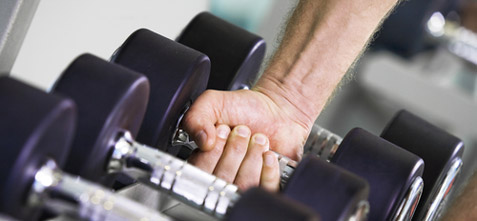
Protein, in and of itself, has little to do with getting fat; protein consumption is inversely related to fat accumulation. The more protein you eat, the more fat you burn as fuel. Protein consumption is directly related to thermogenesis and satiety through multiple mechanisms (6-8). It's what you eat, more than how much you eat, that will determine how lean, strong and muscular you will get.
As discussed earlier, a calorie is not a calorie. A calorie of a carbohydrate does not equate to a calorie of protein when being metabolized in our bodies. Protein calories are not likely to be stored as fat, as compared to carbs, because protein requires more energy to metabolize and assimilate and has numerous functions. Carbs are simply an energy source, and if not used as fuel, they are stored as fat without much effort. Carbs, unlike protein, also stimulate the release of high amounts of insulin, the fat storage hormone.
Protein consumption is not only good for overall health, it's essential to building muscular size and strength. If you do not consume enough quality protein -- and I stress quality -- you will not only put a halt to your efforts to have a leaner, more muscular body, you can actually lose some of the muscle you're working so hard to get. And what burns fat as fuel? Muscle. The more muscle you have, the faster your metabolism.
For a more in-depth explanation about different protein types, read "Protein Rx."
The lean advantage
 Getting lean is a lifestyle. Genetics play a part, as with anything concerning the physiology of the human body, in your ability to get lean. But even the genetically gifted, who can eat more carbs or snack more often than you, will fail without a proper lifestyle which includes consuming the right foods and exercise.
Getting lean is a lifestyle. Genetics play a part, as with anything concerning the physiology of the human body, in your ability to get lean. But even the genetically gifted, who can eat more carbs or snack more often than you, will fail without a proper lifestyle which includes consuming the right foods and exercise.
A proper diet will have the biggest impact on one's quest to get lean. If you continue to eat the wrong food, there isn't a training program or a supplement that will get you to your goal. As discussed earlier, if you're looking for that magic pill or exercise to get you shredded, stop. There is no such thing. If you want to get lean, especially shredded, you are going to have to make a huge commitment to yourself. The word sacrifice also comes to mind.
With the basics of macro-nutrition under your belt, it's time to put it all together. Start by eliminating all processed or convenience foods from your diet. Taking this first step in and of itself will cause you to lose some body fat. The farther away food is from its natural state, the worse it is for you. No more boxed this, or frozen that. Choose as many whole, organic foods as you can.
Take time now to look at the Banned Foods List and the Accepted Foods List. Become familiar with the foods in both lists, as they will help you make better choices at the grocery store.
Once you've stocked your home with the right foods, you're now ready to start on your path to getting lean. You'll need to keep a "Daily Nutrition Progress Report" for at least four days before you make any changes to get an average macro-nutrient intake at your current body fat level. You can't possible make accurate changes to your diet without knowing what you've been eating at your current state. The macronutrients to be concerned with are carbs and protein.
Once you've calculated your averages, make the following changes:
- Calculate 75 percent of your current average carb intake. For example, if your average over four days is 250g, multiply that by 0.75 and it will give you 187.5g.
- If your protein intake is below 1g per pound of body weight, raise it to at least that amount.
Outside of changing your diet to whole natural foods, carbohydrate manipulation will be the most important aspect of your diet, and the key to your success. Make sure to eat at least four times per day, no matter what amount of macronutrients you're consuming. The goal is to try and eat every two to three hours.
In this program you are going to have high carb days and low carb days. Your high day is going to be your four-day average. Your low day is going to be 75 percent of your high day. Organize your high and low days one after another. So if Monday is your high day, Tuesday will be your low day and so on. Never go over the amounts of carbs on either day. If you're hungry and you've eaten your total number of carbs for that day, have more protein and vegetables. Conversely, if you're not quite as hungry on a certain day, it's perfectly fine not to eat your quota of carbs. Eat when you're hungry, stop when you're full.

Maintain the same number of macronutrients for at least three weeks. This will allow enough time for you to see whether or not you're getting results. If at the end of three weeks you're still losing body fat, keep consuming the same amounts. Do not make changes until your body hits a plateau. Once you've stopped losing body fat, drop your low day by another 10 percent. Keep your high day the same and eat more protein and vegetables when you're hungry.
The control you have with this type of diet is a huge advantage. For instance, let's say your low carb days this week land on Monday, Wednesday and Friday. And your high days are on Tuesday, Thursday and Saturday. You are going out to dinner on Friday night and would really like to enjoy yourself, but it's supposed to be your low carb day. Instead of keeping your low day on Friday, make Thursday a low day and Friday the high day. Now your week will look like the following:
Monday = low
Tuesday = high
Wednesday = low
Thursday = low (normally your high day)
Friday = high (the night of your dinner)
Saturday then becomes your low day and you start going every other day again.
Manipulating carb days like this does not give you free reign to eat whatever you want; you are still expected to make healthy choices. This is a method used to cushion the blow to your efforts in getting lean, while going out to eat or attending a party. If your goal is to get lean, there is no reason to stop living. However, as discussed earlier, if attaining a shredded look is what you want, be prepared to sacrifice a great deal. Whatever your goal is, this program is designed to be used for the long haul.
The longer you are on this program the more in tune you'll become with your body. The more in tune with your body you become, the greater the changes to your body. And with these changes will come a great deal of motivation. You'll discover how different foods affect your body, including how they make you feel. You may find that when you eat pasta regularly, even though you stay within your carb quota, you feel bloated and don't seem to lose as much body fat as when you eat whole grain rice or oatmeal. This is why it is imperative you keep a "Daily Nutrition Progress Report." If you don't keep a record of where you've been, it's hard to make accurate adjustments when you end up off course.
Supplementing your success
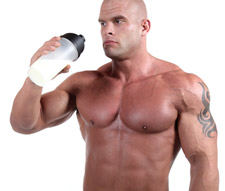 Supplements are supposed to supplement a proper diet and training program. If your diet is piss-poor, and your training is sporadic, supplements are not going to help. Unfortunately, even with all the evidence out there, charlatans relying on pseudoscience get away with peddling their wares to ignorant consumers with hopes of an easy way to get lean, muscular, strong or all the above.
Supplements are supposed to supplement a proper diet and training program. If your diet is piss-poor, and your training is sporadic, supplements are not going to help. Unfortunately, even with all the evidence out there, charlatans relying on pseudoscience get away with peddling their wares to ignorant consumers with hopes of an easy way to get lean, muscular, strong or all the above.
I'm going to cut to the chase. Because of all the misinformation out there, supplements can be a very controversial and misunderstood subject. Below you'll find a list of very popular supplements and a brief description of each. I will also let you know which ones work and which ones don't.
Protein: By far the most important macronutrient in food and supplements you can consume. When your protein sources come from grass-fed ruminant animals, free-range fowl, free-range eggs, and wild-caught fish, you are consuming the most nutritious foods on the planet. Getting away from mass production of foods and returning to local farming would have a huge impact toward improving the health of this nation.
If I had to choose just one supplement to take, protein in the form of micellar casein (MC) would be it. MC, also known as milk protein isolate or milk protein concentrate, has one of the most impressive amino acid profiles. MC has a slow rate of digestion, which gives the user enhanced satiety, and leads to its anti-catabolic properties.
MC's role as an anti-catabolic is unopposed by any other protein. However, one needs to create an anabolic environment also in order to build muscle and get lean. Whey protein comes in three forms: concentrate, isolate and hydrolysate. Concentrate is the least expensive and has the lowest amount of protein per serving. This also equates to lower levels of branched-chain amino acids (BCAA). Isolates are a purer form of whey protein and usually provide 95 percent or more per serving, with a higher BCAA content than concentrates. Hydrolysates are the purest and most rapidly absorbed form of whey, with the highest biological value (BV) of any protein. BV is a measure of how well nitrogen is retained after ingesting a protein source. Muscle cannot repair and build without adequate amounts of nitrogen.
Whey protein is known for its fast delivery of amino acids into the blood stream and into the muscle cells almost immediately after consumption, which elicits its anabolic effects. It would be most beneficial to use an MC/whey mix throughout the day and before you go to sleep. This will give you a steady flow of amino acids throughout the day and during most of the night. The best time to consume whey protein is before, during and after your workout, and upon rising from a good night's sleep. For the best proteins available go to ProteinFactory.com
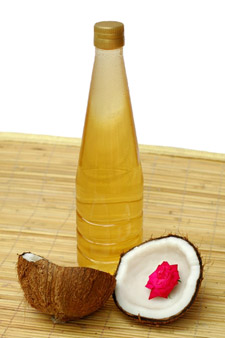 Coconut Oil: Taken from the fruit portion of the seed of the coconut palm tree, coconut oil is one the most beneficial foods you can consume. There is an array of positive research published in the last few years showing the significance of coconut oil (9-11). Coconut oil is the most saturated of all fats. Saturated fat has three subcategories: short chain, medium chain and long chain. Coconut oil contains approximately 65 percent medium chain fatty acids (MCFA). The saturated medium chain lipid, lauric acid, which comprises more than 50 percent of coconut oil, is the anti-bacterial, anti-viral fatty acid found in mother's milk (12). But it's the MCFA's thermogenic (fat burning) effect that we're most concerned about.
Coconut Oil: Taken from the fruit portion of the seed of the coconut palm tree, coconut oil is one the most beneficial foods you can consume. There is an array of positive research published in the last few years showing the significance of coconut oil (9-11). Coconut oil is the most saturated of all fats. Saturated fat has three subcategories: short chain, medium chain and long chain. Coconut oil contains approximately 65 percent medium chain fatty acids (MCFA). The saturated medium chain lipid, lauric acid, which comprises more than 50 percent of coconut oil, is the anti-bacterial, anti-viral fatty acid found in mother's milk (12). But it's the MCFA's thermogenic (fat burning) effect that we're most concerned about.
Researchers compared the thermogenic effect between MCFA's and long chain fatty acids (LCFAs), like those found in vegetable oil after single meals. The meals were 400 calories and consisted entirely of either MCFAs or LCFAs. The thermogenic effect of MCFAs over six hours was three times greater than that of LCFAs. Researchers concluded that as long as the calorie level remained constant, substituting MCFAs for LCFA s would result in weight loss (13). The same number of calories from two different substances yielded different outcomes. How weird.
A study was conducted by researchers at McGill University to evaluate existing data describing the effects of MCFAs on energy expenditure, and to determine their efficacy as agents in the treatment of obesity. They reported that several different studies have shown weight loss equivalent to 12 to 36 pounds a year simply by changing the types of oils used in everyday cooking and food preparation. Animal and human studies have shown greater energy expenditure, less body weight gain, and decreased size of fatty deposits when using MCFAs as opposed to LCFAs (14, 15). How about that calorie theory?
Best source of coconut oil is TropicalTraditions.com
Omega-3 fatty acids: Omega – 3 fatty acids have been referred to as a miracle fat with good reason. These fatty acids are polyunsaturated and refer to a family of fatty acids where the first double bond occurs in the third position. In previous articles and columns I discuss the fact that polyunsaturated fats/oils like soy, corn and canola should be avoided.
The best way to obtain these essential fatty acids is to consume them in their original packaging like wild-caught fish, or by taking a quality supplement. I highly recommend Neutraceutical Science Institute and Flameout.
Omega-3s are an essential part of any diet. In addition to all the health benefits associated with these fats; omega-3s have body fat composition benefits (16-18). They help you lose body fat.
Nitric oxide: Nitric oxide (NO) is a very powerful chemical that, among many functions, regulates blood flow. NO dilates blood vessels and lowers blood pressure, which allows blood to flow more freely. It's this increase in blood flow that has led many in the supplement industry to infer a better delivery of nutrients to muscle cells, which they equate to more muscle. That is one hell of a stretch and just doesn't hold water.
The NO supplements of today are basically the same as the arginine products of the 80s; they're just marketing them differently. Unfortunately, for NO proponents the level of arginine in the blood has little to do with NO production, and consequently has nothing to do with increasing blood flow. If we could increase NO production through diet or supplements, because of the decrease in blood pressure that occurs with higher NO levels, we would have had anecdotal reports of lower blood pressure and syncope (fainting). These types of reports have not occurred, nor have they been found in research.
Need some evidence? Read Robinson et al
Hot-Rox Extreme: a Biotest product, it's the only fat burner that I've used since ephedrine was first banned that has produced any noticeable results. I have found that even without changing my diet, I will notice a reduction in body fat over a 60 day period. Now I'm not saying this product by itself will make you lean. However, used in conjunction with a proper diet it will enhance your efforts.
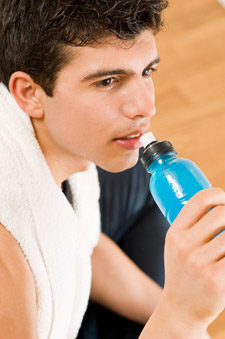 Energy drinks: There are so many companies out there claiming their energy drinks produce long term energy with an enhanced ability to lose body fat. I have tried many different products, and have had many of my friends and colleagues try them as well. I have yet to find one that works.
Energy drinks: There are so many companies out there claiming their energy drinks produce long term energy with an enhanced ability to lose body fat. I have tried many different products, and have had many of my friends and colleagues try them as well. I have yet to find one that works.
Soy products: We have been led to believe that soy is a health food. However, in the United States Food and Drug Administration's Poisonous Plant Database, which contains references to the scientific literature describing studies of the toxic properties and effects of plants and plant parts, there are 288 records under soy (19). The deleterious effects soy has on our bodies are caused by several different substances, but I'm going to briefly review one for the purposes of this article.
The substances contained in soybeans that will hinder your body fat loss are goitrogens. These are naturally occurring and interfere with the function of the thyroid gland. Goitrogens get their name from the term "goiter," which means enlargement of the thyroid gland. Foods that contain goitrogens include broccoli, cabbage, mustard, peanuts, turnips, brussels sprouts and others. However, unlike soy, cooking or fermentation easily neutralizes the goitrogens in these foods. Heat, pressure or chemical (alkaline) solutions commonly used in processing soy will neither deactivate nor remove goitrogens (20). They are virtually in all soy foods, with the highest concentration being in products that are not fermented, like soy milk, protein and baby formula.
Lean principles
As usual, like I do with all topics, I've provided you with no-nonsense information. If implemented properly, this information will help you on your quest to get lean. It will not be easy, especially getting to the point of being shredded, and will take a lot of dedication, patience and self-motivation. Use the basic principles below to get on the right path to changing your lifestyle, which will positively change your life.
- Eliminate all processed convenience foods from your diet.
- Eat whole natural foods.
- Eat at least four times per day.
- Eat protein with every meal.
- Keep a Daily Nutrition Progress Report.
- Eliminate all store-bought oils like soy, corn or canola.
- Don't consume any product that contains "vegetable oil," "hydrogenated vegetable oil," "partially hydrogenated vegetable oil" or "shortening" listed as one of the ingredients.
- Include fats like coconut oil, omega-3s, and raw butter in your diet.
- Use coconut oil and raw butter for cooking and frying. Olive oil can also be used for one time frying, but it doesn't contain the MCTs of coconut oil and butter.
- Exercise intensely two to four times per week. Progressive resistance training is imperative.
- Do not perform slow or moderate cardio unless you enjoy it. It will have little to no effect on your weight loss over the long haul compared to more intense exercise.
- Get adequate sleep.
SOURCES
1. Blaylock, Russel, ed. "Omega-3: Nature's Miracle Panacea". The Blaylock Wellness Report. April, 2005; 2(4).
2. Simopoulos, Artemis. "Omega-3 Fatty Acids in Inflammation and Autoimmune Diseases". J Amer Coll Nutr. 2002; 21(6):495-505.
3. Din, Jehangir N., David E Newby, Andrew D Flapan. "Omega-3 fatty acids and cardiovascular disease – fighting for a natural treatment". BMJ. 2004;328:30-35.
4. "Fish and Omega-3 Fatty Acids". AMH Recommendation. Americanheart.org.
5. Campbell, B et al. J Int Soc Sports Nutr 2007, 4:8.
6. Veldhorst, M et al. "Protein induced satiety: effects and mechanisms of different proteins". Physiological Behavior. 2008;94(2).
7. "The effects of high protein diets on thermogenesis, satiety and weight loss: a critical reiew". J Am Coll Nutr. 2004;23(5).
8. Paddon-Jones, D et al. "Protein, weight management, and satiety". American Journal of Clinical Nutrition. 2008;87(5):1558S-1561S.
9. Enig, Mary. "A New Look at Coconut Oil". westonaprice.org.
10. Rethinam, P. Muhatoyo. "The Plain Truth About Coconut Oil".
11. Enig, Mary. "Latest studies on coconut oil". Wise Traditions in Food, Farming, and the Healing Arts. Spring,2006;7(1).
12. Enig, Mary. "Know Your Fats". Silver Spring: Bethesda Press, 2000.
13. Seaton, T.B., et al. "Thermogenic effect of medium chain and long chain triglycerides in man". Am J of Clin Nutr.1986;44:630.
14. Hill, J., et al. "Thermogenesis in humans during overfeeding with medium chain triglycerides". Metabolism.1989 July;38(7)641-8.
15. Jones, P. "Physiological effects of medium-chain triglycerides: potential agents in the prevention of obesity". J Nutr. 2002 March;132(3):329-32.
16. Hill, AM., et al. "Combining fish-oil supplements with regular aerobic exercise improves body composition and cardiovascular disease risk factors".
17. Kabir, M., et al. "Treatment for 2 mo with n-3 polyunsaturated fatty acids reduces adiposity and some atherogenic factors but does not improve insulin sensitivity in women with type 2 diabetes: a randomized controlled study". Am J Clin Nutr. 2007;86(6):1670-79.
18. Thorsdottir, I., et al. "Randomized trial of weight loss diets for young adults varying in fish and fish oil content". Int J Obesity. 2007;31:1560-66.
19. FDA Poisonous Plant Database.
20. Daniel, Kayla T. "The Whole Soy Story". Washington, New Trends Publishing, 2005.
You can follow us on Twitter and Facebook for content updates. Also, sign up for our email list for weekly updates and check us out on Google+ as well.













